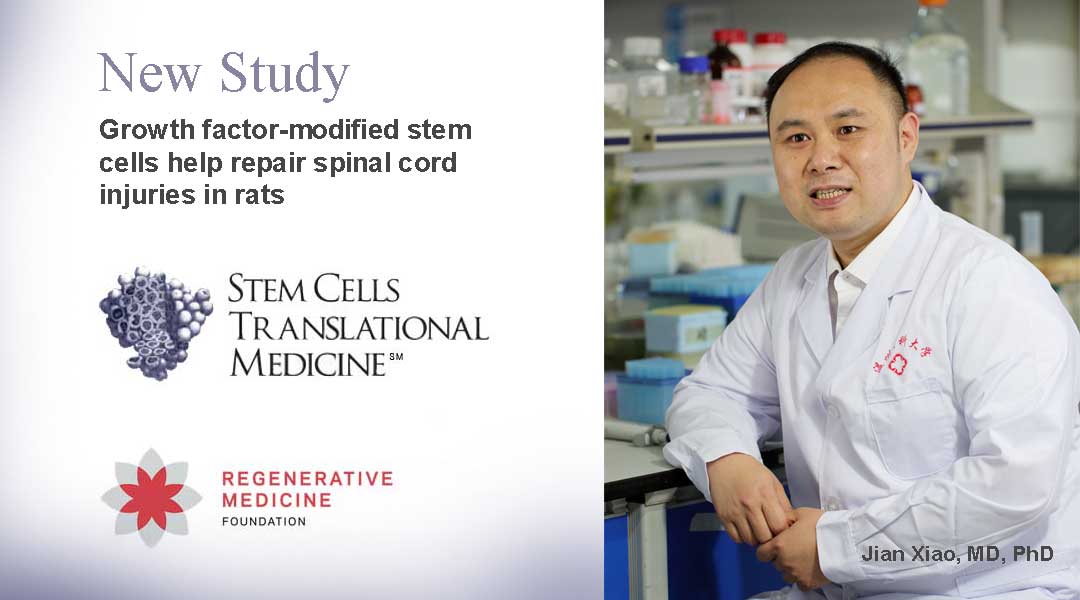Durham, NC – A new study released today in STEM CELLS Translational Medicine is the first to illustrate the presence of oxygen-deprived clusters throughout the damaged site of a compressed spinal cord. It is also the first to show how transplanting basic growth factor with the use of a viral vector to target the oxygen-deprived sites enhances the injured spinal cord’s recovery.
The study, conducted on a rat model that the study’s researchers developed just for their investigation, could eventually have great implications for cellular treatment of spinal cord injury (SCI) in humans.
Every year, according to the World Health Organization, between 250,000 and 500,000 people suffer a spinal cord injury, most due to trauma from accidents. The initial blunt force damages or kills spinal nerve cells, setting in motion a cascade of secondary events that include loss of an adequate oxygen supply at the tissue level — a condition called hypoxia. The results could lead to complete paralysis, depending on the severity of the injury and where along the spinal cord it occurs.
There is currently no effective way to repair the damage. “A better understanding of the events of secondary injury would provide a target to optimize pharmacological and cellular therapies, the timing of surgery and early rehabilitation,” said Jian Xiao, M.D., Ph.D. He served as senior author of this new study, conducted with his colleagues at Wenzhou Medical University in Zhejiang, China.
The team focused on the hypoxia aspect of an SCI. To begin, they established a compressive rodent model of SCI. “We then investigated the SCI using this rat model and found that areas of hypoxia were unevenly interspersed throughout the injured sites,” Dr. Xiao said.
Armed with this new knowledge, the team generated embryonic neural stem cells (NSCs) expressing basic
fibroblast growth factor (bFGF), under the regulation of five hypoxia-responsive elements. They then used a lentiviral vector (LV-5HRE-bFGF-NSCs) to specifically target the oxygen-deprived locations. “A number of growth factors have been shown in previous studies to reduce the harmful effects of an SCI while improving neuronal survival and regeneration,” Dr. Xiao explained. “However, controlling the release of these factors has been a significant challenge. That’s why we introduced the lentiviral vector. We suspected it might ensure the bFGF made it to the hypoxia-targeted sites.”
Results showed their suspicions were correct. At 60 days after SCI, the rats showed a reversal of the hypoxic microenvironment, paralleled by a decrease in cellular autophagy (a process that can lead to cell death) and reduced glial scar formation (glial scars can set up a barrier that interferes with delivering a therapy to the injured site). The team also saw an increase in axon regeneration and better locomotor function in the treated animals.
“This approach allows bFGF to target the right place at the right time and has the therapeutic potential to treat SCI via a timely improvement in the microenvironment,” said Sipin Zhu, M.D., the paper’s first author.
“These findings led us to propose that LV-5HRE-bFGF-NSCs might, therefore, be a good candidate to evaluate cellular SCI therapy in humans,” Dr. Xiao added.
“This study, focusing on spinal cord injury, shows that recovery is possible in a preclinical model,” said Anthony Atala, M.D., Editor-in-Chief of STEM CELLS Translational Medicine and director of the Wake Forest Institute for Regenerative Medicine. “The use of growth factor-modified stem cells is promising and warrants further investigation.”
###
The full article, “The repair and autophagy mechanisms of hypoxia-regulated bFGF-modified primary embryonic neural stem cells in spinal cord injury,” can be accessed at https://stemcellsjournals.onlinelibrary.wiley.com/doi/abs/10.1002/sctm.19-0282.
About STEM CELLS Translational Medicine: STEM CELLS Translational Medicine (SCTM), co-published by AlphaMed Press and Wiley, is a monthly peer-reviewed publication dedicated to significantly advancing the clinical utilization of stem cell molecular and cellular biology. By bridging stem cell research and clinical trials, SCTM will help move applications of these critical investigations closer to accepted best practices. SCTM is the official journal partner of Regenerative Medicine Foundation.
About AlphaMed Press: Established in 1983, AlphaMed Press with offices in Durham, NC, San Francisco, CA, and Belfast, Northern Ireland, publishes two other internationally renowned peer-reviewed journals: STEM CELLS® (http://www.StemCells.com), celebrating its 38th year, is the world’s first journal devoted to this fast paced field of research. The Oncologist® (http://www.TheOncologist.com), also a monthly peer-reviewed publication, entering its 25th year, is devoted to community and hospital-based oncologists and physicians entrusted with cancer patient care. All three journals are premier periodicals with globally recognized editorial boards dedicated to advancing knowledge and education in their focused disciplines.
About Wiley: Wiley, a global company, helps people and organizations develop the skills and knowledge they need to succeed. Our online scientific, technical, medical and scholarly journals, combined with our digital learning, assessment and certification solutions, help universities, learned societies, businesses, governments and individuals increase the academic and professional impact of their work. For more than 200 years, we have delivered consistent performance to our stakeholders. The company’s website can be accessed at http://www.wiley.com.
About Regenerative Medicine Foundation (RMF): The non-profit Regenerative Medicine Foundation fosters strategic collaborations to accelerate the development of regenerative medicine to improve health and deliver cures. RMF pursues its mission by producing its flagship World Stem Cell Summit, honouring leaders through the Stem Cell and Regenerative Medicine Action Awards, and promoting educational initiatives.

